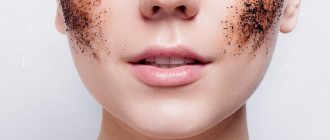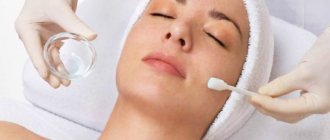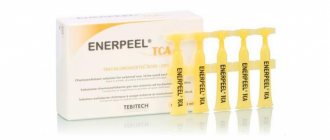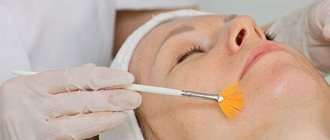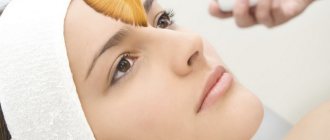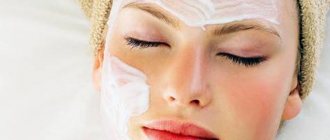What is the difference: home peeling and peeling at a cosmetologist
Peels that can be used at home do not penetrate deeply into the skin and give an unnoticeable result, but they certainly help maintain an even tone and healthy skin. Chemical peels performed by estheticians have a lower pH level than at-home peels, so they can penetrate much deeper into the skin and target skin problems such as hyperpigmentation and acne. Chemical peels can cause redness of the skin; a recovery period will last for several days, during which the “old” skin will gradually peel off and renewed skin will appear.
Chemical peeling performed by cosmetologists will be much more effective for your skin than peeling at home.
Benefits of chemical peeling for the face
In order to fully appreciate the advantages of chemical peeling, you should first of all understand that the technique is aimed at completely cleansing the surface layers of the skin from keratinized epidermal cells, excess sebaceous secretions and polluting agents . The essence of the procedure is to receive a controlled light chemical burn under the influence of an acid or enzyme composition, as a result of which the skin is cleansed and renewed, forming a young, healthy epidermal layer.
The effectiveness of chemical peeling lies in the following aesthetic and physiological effects:
- Skin cleansing . Under the influence of acid, a significant weakening of the intercellular connections of the stratum corneum occurs, which leads to the elimination of dead cellular structures. A similar reaction is observed in relation to sebum and the contents of the epidermal ducts. As a result, the skin is cleansed of excess surface elements, acquiring an even structure and a healthy color tone.
- Rejuvenation . The anti-age effect that can be achieved by chemical peeling is due to the complete renewal of the surface layers of the epidermis. After the chemical destruction of dead skin cells, an active regeneration process is launched, which leads to the formation of new, young skin cells. In addition, the activation of internal growth factors provokes the production of collagen and elastin by cellular fibrils, which results in increased elasticity and firmness of the skin, as well as smoothing of epidermal facial wrinkles and skin creases.
- Normalization of the sebaceous glands . Cosmetologists especially often recommend peeling procedures to patients with oily skin. This is explained not only by the ability to clear clogged gland ducts from natural secretions, but also by the effect of optimizing the functioning of the sebaceous glands and narrowing the skin channels. A full course of peeling procedures significantly reduces the oiliness of the epidermis and eliminates the manifestations of acne and acne, restoring the natural beauty of the facial skin.
- Elimination of skin defects . Chemical peeling is often used as a therapeutic technique for eliminating scars, scars, especially those formed as a result of acne, as well as age spots. The last aspect is based on the fact that the melanin pigment is produced in the superficial skin structures, which are quickly renewed under the influence of peeling.
Considering the relationship between the pros and cons of chemical peeling, we can clearly draw conclusions in favor of this cosmetic procedure, since it is almost impossible to achieve the appropriate aesthetic effects without the use of chemical agents.
Contraindications:
- The procedure is not recommended for pregnant and lactating women;
- When taking medications based on isotretinoin;
- For herpes and skin diseases;
- When taking antibiotics;
- For oncological diseases;
- For open wounds.
After a chemical peel, the skin is more sensitive to sunlight, so after the procedure it is necessary to use sunscreens and products.
Before the procedure, the cosmetologist must take into account many factors and ask all the necessary questions so that the procedure is as comfortable as possible for the client and gives the best result with the fewest possible side effects.
What is this procedure
Peeling - translated from English means “cleaning” . This is one of the techniques, the effect of which is to cleanse the face of dead skin cells.
The first procedures were carried out in Ancient Egypt. Sand, mineral particles, and crushed fruit seeds were used as cosmetic mixtures. Even then, processing was multi-stage.
At the same time, chemical cleaning began to be used, where natural acids were used as a remedy.
About a hundred years ago, phenol peeling was invented , which became the prototype of modern methods.
How is peeling performed and what should you pay attention to after the procedure?
Before the procedure, the skin is cleansed and “degreased”. During the procedure, you will feel warmth and burning on the treated skin surface. To reduce discomfort, you can use a fan or local anesthetic. After peeling, first of all, take care of protecting your skin from the sun, so it is not recommended to carry out the procedure at the height of summer or before leaving for warm countries.
After peeling, you will feel tightness and slight dryness of the skin. The skin may remain red for an hour after the procedure. The condition of the skin in the post-peeling period depends on the type of skin and the type of peeling performed.
It is recommended to avoid excessive physical activity and excessive sweating for several days after the procedure. Do not rub the treated skin area after peeling. Do not use retinol or AXA products for at least 10 days after peeling. Avoid visiting the sauna or bathhouse for several days.
Is chemical peeling harmful to the face?
Speaking about the dangers of chemical peeling, it is worth mentioning that there are a number of contraindications, which most often provoke complications and the development of unpleasant consequences of this cosmetic technique. Most often, if the procedure protocol is followed and there are no contraindications, chemical peeling does not cause significant side effects. At the same time, a number of temporary post-peeling reactions are always observed, which you should know about in advance when deciding to carry out this cosmetic procedure:
- Chemical burn of the skin - this concept primarily means hyperemia and swelling of the tissue, which can be accompanied by the formation of crusts and active peeling. Typically, this reaction persists for the first few days to a week after peeling.
- Dry tissue – one of the disadvantages of peeling is some dryness of the skin, which patients usually note in the first week after the procedure. Such a reaction is completely natural and is compensated by subsequent active hydration of tissues.
- Hypersensitivity to exposure to sunlight - manifested by an increased risk of developing age spots. This effect is typical for almost all types of chemical acid peeling, which imposes some restrictions on its implementation - it is recommended to do it only in the autumn-winter period.
Assessing the benefits and harms of chemical peeling, we can certainly conclude that this procedure has many more positive effects than negative skin and body reactions. At the same time, a decision on the need and advisability of peeling and the choice of a specific technique should be made only on the basis of consultation with a professional cosmetologist who can assess the individual characteristics of the skin condition. Cosmetologists are ready to provide informative advice and conduct effective and safe chemical peeling of the face.
Find out the cost of the Chemical Peeling procedure
Pros and cons compared to other cleansing methods
Peeling, compared to scrubs and facial cleansing, has a deeper effect . It is recommended for signs of aging, helps get rid of freckles and skin blemishes.
For young women, such procedures are a good way to prevent the appearance of wrinkles. They help even out the complexion.
The biostimulants, moisturizers and other beneficial substances included in the peels prevent the occurrence of complications.
Some procedures promote the synthesis of your own collagen and elastin , as a result, natural rejuvenation processes are launched in the body.
Scrubs, as facial cleansers, have a lighter effect. You can make healthy scrubs at home yourself. They help get rid of dead cells.
The purpose of standard facial cleansing is to get rid of dirt, secretions and sebum, there is no rejuvenation or renewal effect.
The disadvantages of peelings compared to scrubs are that they are traumatic and have contraindications.
What types of professional peeling can be done in summer?
- Gas-liquid peeling.
Summer conversion can be carried out using hardware techniques. Particularly popular is gas-liquid peeling, which is known for its all-season use. This technology is a breakthrough, recommended for dry and aging skin, wrinkles, stretch marks, acne.
Using oxygen, the doctor applies beneficial compounds to the skin, which penetrate the dermis and affect problems at the required level. The procedure is safe and can be performed even on sensitive areas, such as the eyelids. The visual effect can be achieved after the second session, but to consolidate it you should take a course.
The durability of the result is about six months. The creators of the technology claim its anti-aging and immunomodulatory effects. The procedure carried out in the summer will provide an even sun tan.
We offer you to watch a video about the specifics of gas-liquid peeling in the summer:
- Ultrasonic peeling.
Ideal for thin sensitive skin. It is the most painless option for manipulation. Before the procedure, the skin should be cleansed with a toner and a special conductive cream should be applied. Using ultrasound, the master will use the device to expand and cleanse the pores, dead cells will be removed, and the skin will begin to breathe. The massage effect will improve nutrition and gas exchange at the cellular level. The procedure is carried out quite quickly. You will need to give it about half an hour.
- Laser peeling.
Known as laser skin resurfacing. It is a radical technique. Recommended for people with obvious signs of skin aging, bumpy dermis after comedones or acne. It is usually introduced into skincare procedures after the age of 30.
Before going to the session, discuss this issue with your cosmetologist. Find out if the specialist has a medical education. The procedure must be performed in a clinic under local anesthesia. Laser peeling is not a cheap procedure, so you can agree to perform it on certain areas.
For a good effect, it is necessary to carry out three to five procedures (the number depends on the individual characteristics of your skin) with an interval of at least two weeks. After peeling, the skin will recover for several days, redness will subside within a few hours. You will have to carefully take care of the skin, without in any way injuring it.
- Mesopeeling.
If you are not ready to drop out of life for a while, mesotherapy with glycolic acid will come to your aid. After the procedure, there is no obvious inflammation or redness on the skin, it will not peel off. This peeling has clear advantages and is not limited in terms of seasonality. Mesotherapy does not violate the protective properties of the dermis. Unlike the most delicate peelings, it can be used on tanned skin, which means no preliminary preparation is required. If you have just started a course of procedures, carry them out at least once every two weeks. Then you can increase this period.
Read material on the topic: Gas-liquid skin peeling - beauty without pain and injections


